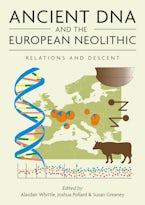One of the principal characteristics of the European Neolithic is the development of monumentality in association with innovations in material culture and changes in subsistence from hunting and gathering to farming and pastoralism. The papers in this volume discuss the latest insights into why monumental architecture became an integral part of early farming societies in Europe and beyond. One of the topics is how we define monuments and how our arguments and recent research on temporality impacts on our interpretation of the Neolithic period. Different interpretations of Göbekli Tepe are examples of this discussion as well as our understanding of special landmarks such as flint mines.
The latest evidence on the economic and paleoenvironmental context, carbon 14 dates as well as analytical methods are employed in illuminating the emergence of monumentalism in Neolithic Europe. Studies are taking place on a macro and micro scale in areas as diverse as Great Britain, Denmark, Sweden, Poland, Germany, the Dutch wetlands, Portugal and Malta involving a range of monuments from long barrows and megalithic tombs to roundels and enclosures. Transformation from a natural to a built environment by monumentalizing part of the landscape is discussed as well as changes in megalithic architecture in relation to shifts in the social structure. An ethnographic study of megaliths in Nagaland discuss monument building as an act of social construction. Other studies look into the role of monuments as expressions of cosmology and active loci of ceremonial performances. Also, a couple of papers analyse the social processes in the transformation of society in the aftermath of the initial boom in monument construction and the related changes in subsistence and social structure in northern Europe.
The aim of the publication is to explore different theories about the relationship between monumentality and the Neolithic way of life through these studies encompassing a wide range of types of monuments over vast areas of Europe and beyond.
Introduction. Gebauer, A. B., Sørensen, L., Teather, A. & A. C. Valera.
List of contributors.
List of content.
Thoughts on Monumentalism
Chapter. 1. Teather, A. Neolithic monumentality for the 21st Century.
Origin of Monumentalism
Chapter. 2. Watkins, T. Monumentality in Neolithic Southwest Asia: making memory in time and space
Chapter. 3. Kinzel, M. and Clare, L. Monumental compared to what? A Perspective from Göbekli Tepe
Chapter. 4. Hodder, I. From communal to segmentary: an alternative view of Neolithic ‘monuments’ in the Middle East. Comments on chapter 2 and 3
Chapter. 5. Jeunesse, Chr. Elite houses or specialised buildings? Some comments about the special buildings of Göbekli Tepe in relation to chapter 2 and 3
Chapter. 6. Response to comments by Ian Hodder and Christian Jeunesse by Trevor Watkins
Chapter. 7. Response to comments by Ian Hodder and Christian Jeunesse by Lee Clare and Moriz Kinzel with notes on a potential Upper Mesopotamian “Late PPNA Hunter-Crisis”
Monuments and social change
Chapter. 8. Sørensen, L. Monuments and social stratification within the early Funnel Beaker Culture in South Scandinavia
Chapter. 9. Behrens, A. Do Hundreds of megalithic monuments signify a full Neolithic way of life? The establishment of Neolithic societies on Rügen Island, Germany
Chapter. 10. Brozio, J. P. From hierarchies in balance to social imbalance - transformation processes in the later Funnel Beaker north societies in the western Baltic Sea region (3100-2900 BCE)
Chapter. 11. Müller, J., J. P. Brozio, W. Dörfler and W. Kirleis Narratives of third millennium transformations: new biographies of Neolithic societies, landscapes and monuments
Chapter. 12. Nobles, G. Settling the Monumental Issue in the Dutch Wetlands
Chapter. 13. Wunderlich, M. Celebrating stones – Megalith building traditions among Angami-Naga, Northeast-India
Chapter. 14. Wadskjær, A.V. & G. Hjortlund Megalithic structures and settlements in the Valley of Posic, Amazonas, Northern Peru
Funerary monuments
Chapter. 15. Larsson, L. Stones as Boundaries – Stones as Markers. A megalithic tomb in Southern Portugal
Chapter. 16. Pospieszny, Ł., M. Jakubczak and G. Kiarszys Putting earthen long barrows back on map. Remarks about the Middle Neolithic monumentality of northern Poland
Chapter. 17. Papiernik, P., R. Brzejszczak, D. Kacper Płaza, J. Wicha, and P. Wronecki In the search of the lost heritage. Non-invasive exploration of the monumental Funnel Beaker culture long barrows
in the area of Wietrzychowice in central Poland
Chapter. 18. Sheridan, A. and R. Schulting Making sense of Scottish Neolithic funerary monuments: tracing trajectories and understanding their rationale
Chapter. 19. Gebauer, A. B. Group benefits? The story of a cluster of megalithic monuments in Danish Funnel Beaker society
Enclosures and Landscapes
Chapter. 20. Parkinson, E., S. Stoddart, C. Malone, C. Brogan and R. McLaughlin Storied Structures, Sustainability and Resilience in late Neolithic Malta: Excavations at the Santa Verna, Gozo
Chapter. 21. Valera, A. C. Ephemeral and Cosmological Monumentality: the ‘strange’ ditched enclosures of Chalcolithic South Portugal
Chapter. 22. Sanches, M. J. and A. M. Vale Connecting stories of the Neolithic in North-Eastern Portugal. Walled enclosures and their relationships with the genealogy of the landscape.
Chapter. 23. Czerniak, L., A. Matuszewska, M. Dziewanowski, L. Pospieszny, M. Jakubczak and M. Szubski The Neolithic roundel and its social context on the furthest reaches of the Danubian World.
Chapter. 24. Andersson, M. and M. Artursson, The living and the dead – the Early Neolithic monumental landscape of southwestern Scania, southern Sweden.
Conclusion:
Chapter. 25. Thomas, J. The Lives of Monuments and Monumentalising Life












